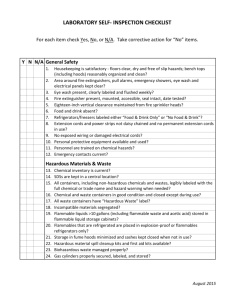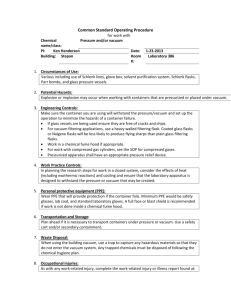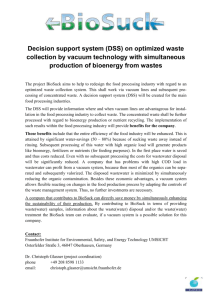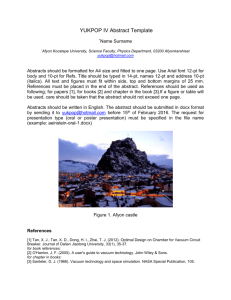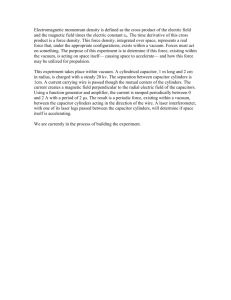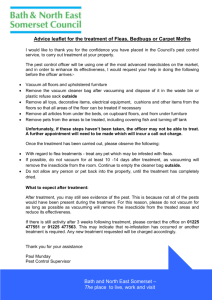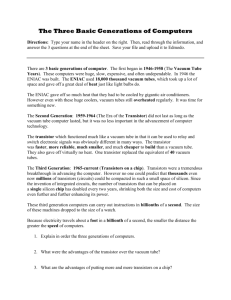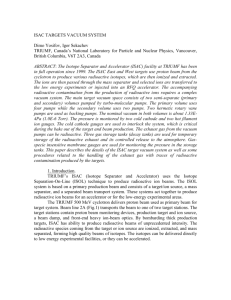10-30-2003 - University of Kentucky
advertisement
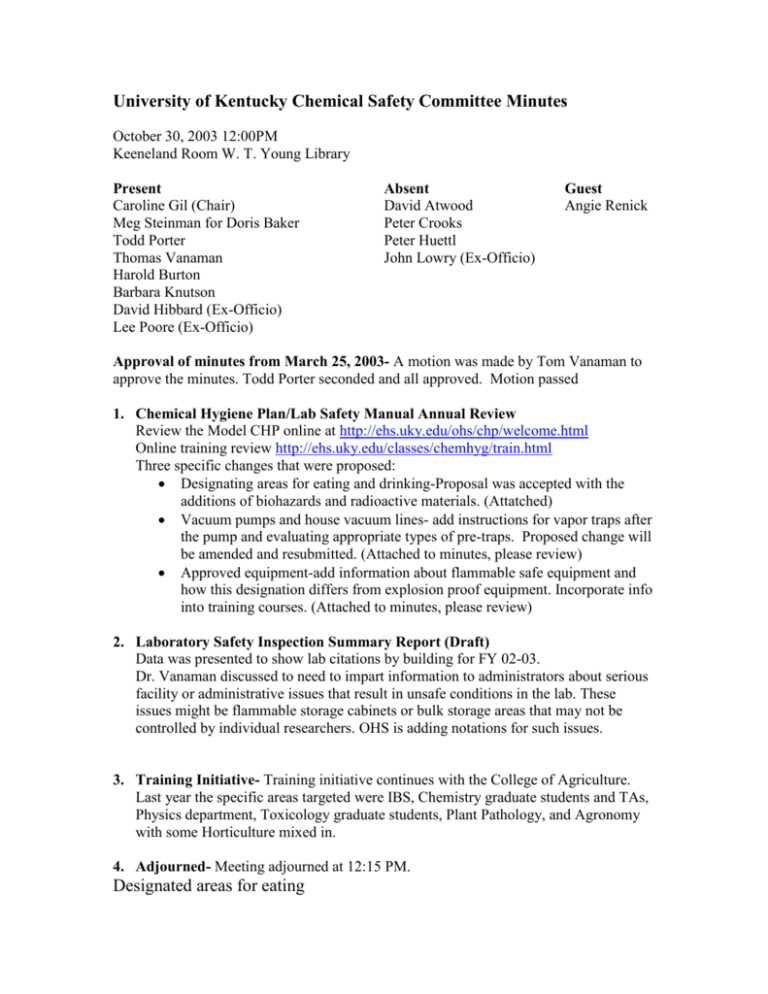
University of Kentucky Chemical Safety Committee Minutes October 30, 2003 12:00PM Keeneland Room W. T. Young Library Present Caroline Gil (Chair) Meg Steinman for Doris Baker Todd Porter Thomas Vanaman Harold Burton Barbara Knutson David Hibbard (Ex-Officio) Lee Poore (Ex-Officio) Absent David Atwood Peter Crooks Peter Huettl John Lowry (Ex-Officio) Guest Angie Renick Approval of minutes from March 25, 2003- A motion was made by Tom Vanaman to approve the minutes. Todd Porter seconded and all approved. Motion passed 1. Chemical Hygiene Plan/Lab Safety Manual Annual Review Review the Model CHP online at http://ehs.uky.edu/ohs/chp/welcome.html Online training review http://ehs.uky.edu/classes/chemhyg/train.html Three specific changes that were proposed: Designating areas for eating and drinking-Proposal was accepted with the additions of biohazards and radioactive materials. (Attatched) Vacuum pumps and house vacuum lines- add instructions for vapor traps after the pump and evaluating appropriate types of pre-traps. Proposed change will be amended and resubmitted. (Attached to minutes, please review) Approved equipment-add information about flammable safe equipment and how this designation differs from explosion proof equipment. Incorporate info into training courses. (Attached to minutes, please review) 2. Laboratory Safety Inspection Summary Report (Draft) Data was presented to show lab citations by building for FY 02-03. Dr. Vanaman discussed to need to impart information to administrators about serious facility or administrative issues that result in unsafe conditions in the lab. These issues might be flammable storage cabinets or bulk storage areas that may not be controlled by individual researchers. OHS is adding notations for such issues. 3. Training Initiative- Training initiative continues with the College of Agriculture. Last year the specific areas targeted were IBS, Chemistry graduate students and TAs, Physics department, Toxicology graduate students, Plant Pathology, and Agronomy with some Horticulture mixed in. 4. Adjourned- Meeting adjourned at 12:15 PM. Designated areas for eating Current Food, Drink, Cosmetics Eating, drinking and the application of cosmetics (including lip balm) is forbidden in areas where hazardous chemicals are used and must be done only in well-defined designated non-chemical areas. Do not store food in the same refrigerator with chemicals, biohazards or radioactive materials, refrigerators, microwaves and ice machines must have labels that denote their use, i.e. “Not for food or drink.” Proposed change: Food, Drink, Cosmetics Eating, drinking and the application of cosmetics (including lip balm) are forbidden in areas where hazardous chemicals, biohazards and radioactive materials are used. These activities must be in designated, well defined non-chemical areas that are separated from the lab area by a physical barrier such as partitions or filing cabinets. A line on the floor will not be considered adequate separation. Do not store consumables in the same refrigerator with chemicals, biohazards or radioactive material. Reasoning: This will better clarify areas acceptable for food storage and consumption. This is what OHS has been recommending and it resembles what the KY regulators for radioactive material. In that case, regulators have interpreted separation from “use” and “non-use” space as having partitions and a closed door. Will eliminate the need to label all appliances in the labs. Approved equipment Current Equipment Use proper equipment that is in good condition, For example, never use chipped or cracked glassware. Shield pressurized or vacuum apparatus and safeguard against bumping or overheating. Proposed: Equipment Use proper equipment that is in good condition. For example, never use chipped or cracked glassware. Use flammables with only approved equipment such as blenders. Flammables that require cooler temperatures for storage should be put in specific refrigerators. There are two types: Flammable safe refrigerators and freezers have no exposed ignition sources inside the cabinet, such as lights or switches that could ignite vapors. These are less expensive than the explosion-proof type and would be adequate for most lab applications. An explosion-proof refrigerator or freezer may be required in rare circumstances for hazardous locations. Explosion-proof or spark-proof units have no interior or exterior ignition sources and are considerably more expensive. Contact OH&S or the Fire Marshal for more information. Reasoning: We have found many labs with flammables stored in non-industrial refrigerators not intended for such use. This poses a significant risk in the laboratory. Two types of flammable storage units are commercially available: Flammable storage refrigerators and freezers have no exposed ignition sources inside the cabinet, such as lights or switches that could ignite vapors. An explosion-proof refrigerator or freezer may be required in rare circumstances in hazardous locations. Explosion-proof or spark-proof units have no interior or exterior ignition sources. Vacuum pumps Current: There is no written information about vacuum procedures in the CHP Proposal: Vacuum Pumps and Vacuum Lines Vacuum lines leading from an experimental procedure shall always be equipped with traps to prevent contaminating of vacuum equipment or house lines. Traps shall be evaluated for appropriateness and special safety precautions instituted if needed. √ √ √ √ Particulates: determine size range being generated and choose capable filtration Aqueous non-volatile: in most cases a filter flask at room temperature will prevent liquids from contaminating vacuum source Solvents or other volatile liquids: a cold trap that is large enough and cold enough to condense vapors plus a filter flask large enough to hold all possible liquids that could be aspirated. Avoid using liquid nitrogen if at all possible. Liquid Nitrogen should only be used in sealed or evacuated equipment and with extreme caution. Liquid oxygen can form if proper procedures are not followed. For most applications a slurry of dry ice and isopropanol or ethanol can be used. Corrosive, highly reactive or toxic gases: a sorbent canister or scrubber shall be used that can trap the contaminant. Reasoning: Biosafety Officer has found labs that are not following this practice.

